Taxonomy
Syllides verrilli Moore 1907:448-415, figs. 1,2; - Banse 1971: 1475-1476, fig. 4
Syllides setosa - Pettibone 1963:126, not S. setosa Verrill 1882.
Descriptions
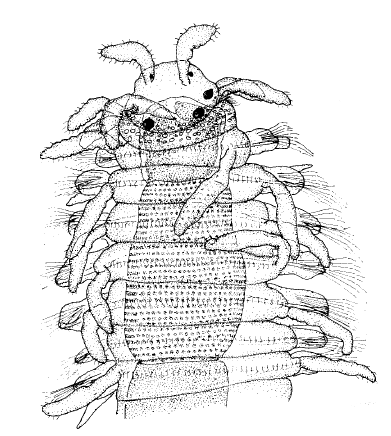 Body short and broad, small numbers of chaetigers. Prostomium subpentagonal, margins rounded. Four large red eyes with lenses in trapezoidal arrangement and two anterior eyespots. Antennae short, club-shaped, subdistally thicker than basally. Median antenna slightly longer than prostomium, inserted between posterior eyes. Lateral antennae shorter than median one, inserted near anterior margin of prostomium and the eyespots. Palps reduced to two frontal minute papillae. Peristomium clearly separated, with golden inclusions. Two pairs of tentacular cirri, dorsal ones in shape and length similar to lateral antennae, ventral ones shorter. Two lateral ciliated nuchal organs. Segments well defined, with dorsal ciliary band.
Body short and broad, small numbers of chaetigers. Prostomium subpentagonal, margins rounded. Four large red eyes with lenses in trapezoidal arrangement and two anterior eyespots. Antennae short, club-shaped, subdistally thicker than basally. Median antenna slightly longer than prostomium, inserted between posterior eyes. Lateral antennae shorter than median one, inserted near anterior margin of prostomium and the eyespots. Palps reduced to two frontal minute papillae. Peristomium clearly separated, with golden inclusions. Two pairs of tentacular cirri, dorsal ones in shape and length similar to lateral antennae, ventral ones shorter. Two lateral ciliated nuchal organs. Segments well defined, with dorsal ciliary band.
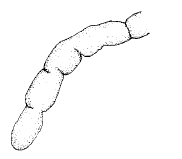
Dorsal cirri rough, short, similar to antennae but less thickened distally, about twice the length of parapodial lobe, with cirrophore. Occasionally pseudoarticulated. Appendices ciliated, especially distally.
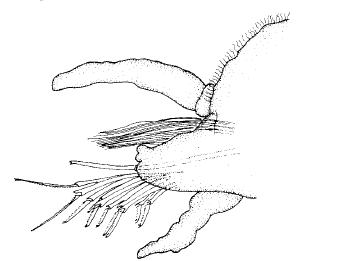
Parapodia conical with two dorsal papillae. Ventral cirri conical with broad bases, rough, pseudoarticulate, longer than parapodial lobe.
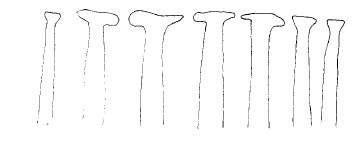
One distally knobbed acicula per parapodium, enlarged in 2-5 enlarged, in chaetiger 6 less thickened than the anterior ones but more than the ones following.

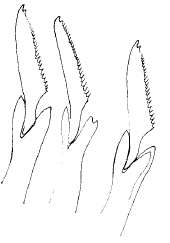
In anterior 6 chaetigers ca. 15 hemigomph compound chaetae per parapod, with thick subdistal spine on shaft. Three upper chaetae with long blades, spiniger-like, finely serrated, minutely bidentate. 12 lower falcigers with larger serration on blades, bidentate with proximal teeth.
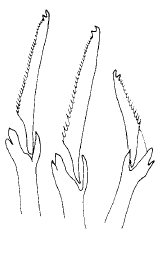
Remaining chaetae with 2 spinigers and 8 falcigers, all bidentate and serrated.
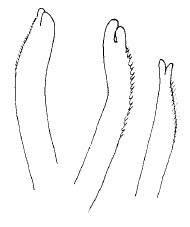

Dorsal simple chaeta from chaetiger 1, thick, serrated, bidentate, with the teeth large and rounded. On posterior chaetigers single ventral simple chaeta present, indistinctly bifid.
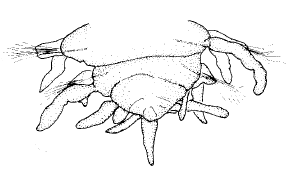
Pygdium triangular, with two lateral anal cirri and a medial cirrus.
Pharynx unarmed, through about 3 segments, with a crown of 10 papillae surrounding opening. Proventriculum twice as long as pharynx, extending over 4.5 segments.
Epitokous males with sperm from chaetiger 7-26, a slender curved notoaciculum and a tuft of short natatory chaetae in mature segments.
Streptosyllis, unlike Syllides, has long ventral cirri which are broad at the base, sometimes pseudoarticulated. S.verrilli has ventral cirri similar to Streptosyllis websteri , S. templadoi and others. Dorsal cirri in Syllides are are smooth and short anteriorly and long and articulated from chaetiger 3, the dorsal cirri of Streptosyllis are rough to pseudoarticulated, as in S. verrilli. S. verrilli shows the following unique combination of characters: 1. papilliform palps, 2. dorsal cirri rough to pseudoarticulated, 3) dorsal simple chaetae thick and bidentate, 4) enlarged aciculae from chaetiger 2-6.
Sources
Distribution
Ecology
for population dynamics see . 1992. Streptosyllis verrilli (Moore, 1907), new combination, life cycle, population dynamics and production from a salt marsh in southern New England.
Creeks and shallow waters, up to 5cm in depth in sandy sediments, coarse to medium grain sized sand, not found in sediments below 0.12mm grain size or in coarse beach sediments.

Add new comment